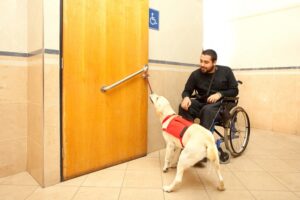Normalizing Disability in the Healthcare Workplace: A Benefit for Everyone
Stacey J. Drubner, JD, LICSW, MPH

EAP Ask the Experts: Zary Amirhosseini, M.Ed., Manager, Massachusetts General Hospital Disability Program, & Cheri Blauwet, MD, Interim Chief Medical Officer, Spaulding Rehabilitation Hospital; Attending Physician, Brigham and Women’s Hospital
In the last few decades, the workplace has made progress with being more accessible for people with disabilities. Part of this is related to legislation such as The Americans with Disabilities Act (ADA). After 30 years + since this Act was passed, the hope is that we can achieve a more advanced phase of inclusion and normalcy. This requires mitigating workplace ableism – (discrimination and stigma based on a disability), and moving away from “the idea that non-disabled people are more worthy than disabled people, more valuable, more talented.” The key to a paradigm shift lies in education, continued innovation, and authentic acceptance and normalizing.
To gain a better understanding of this topic, the EAP partnered with experts Zary Amirhosseini and Dr. Cheri Blauwet, from the Mass General Brigham Disability Task Force.
The U.S. Bureau of Labor Statistics (2021) reported that 7.9 % of persons with a disability were employed, with healthcare representation: practitioners – 4.4%, and healthcare support positions – 4%. During this same time period, there was a decrease in people with disabilities in the workforce, with an unemployment rate of 12.6% for this population. These stats are based on a limited definition of disability.
For purposes of this article, we will use the description and definitions referenced in the recently released Mass General Brigham Office of Diversity, Equity & Inclusion – Disability Toolkits. “Disability is a broad term that can be used to encompass a wide range of conditions that may occur across the life span.” Areas include:
- Physical
- Mental health
- Intellectual
- Blindness, low vision, or deafness
- Chronic illness

Non-visible Disabilities
Not all disabilities are visible or obvious. Zary explains that a good starting point is to understand the types of conditions that can be associated with non-visible disabilities.
Here are some examples:
• Mental illness
• Medical conditions such as Diabetes, Lupus or Cancer
• Chemical sensitivity
• Autism and Neurodiversity
Zary Amirhosseini
Not all the above conditions rise to the level of a disability or require an accommodation (discussed more fully below). So how do you know what to do or how to interact with someone who might be a person with a non-visible disability? Zary recommends an open-minded and non-judgmental approach for all individuals.
- Be sensitive to a variety of employees and potential non-visible disabilities
- Show flexibility and patience
- Don’t make assumptions regarding disability status
– Being “different” may not signify a disability - Be open to understanding individual needs for thriving
– For example, a person with a learning disability may require repeating of information or an assignment
Organizational Benefits to Employing People with Disabilities
Being inclusive and accommodating is the “human” and ethical thing to do, but research shows that it also benefits the workplace and taps into a skilled workforce population. A study from Accenture, with Disability: IN, & the American Association of People with Disabilities, reported that:
- Companies that embrace best practices for employing and supporting more persons with disabilities in their workforce have outperformed their peers
- Organizations which are disability inclusion champions:
– Exhibit better innovation
– Have greater productivity ratings
– Enjoy a more favorable reputation
– Perform above-average financially
The take-away is that organizations can realize benefits through processes which “employ, enable, engage, and empower” people with disabilities.
When discussing benefits specific to the healthcare space, Zary points out that those with disabilities, or family members with disabilities, enhance the patient experience by virtue of the fact that they are aware of barriers firsthand. Beyond their medical industry skills, they understand the consequences of not having automatic doors, close parking, adjustable exam tables or someone misinterpreting what it means to have a mental illness.
Their knowledge base and relevant experience offers opportunities for:
- Normalizing
- Providing validation, a sense of connection and compassion
- Offering ideas for innovation
- Conveying how to advocate in the medical system
The Potential Consequences of being a Patient with a Disability
Perhaps the healthcare industry has the most at stake for ensuring that the workplace is inclusive and accessible for people with disabilities. The health status of this population is impacted by disparities and barriers, including:
- Attitudinal
- Physical
- Communication-based
- Financial
According to the World Health Organization (WHO) and Centers for Medicare and Medicaid Services (CMS), these barriers have significant consequences which impact health outcomes, quality of life and healthcare costs. People with disabilities are:
- Three times more likely to be denied health care
- Four times more likely to be treated badly in the health care system
- 50% more likely to suffer a catastrophic health expenditure
- Less likely to receive:
– Comprehensive preventive care
– Diagnostic imaging
– Recommended cancer screenings
The Pandemic represented limitations for all of us, but those with disabilities often faced extra challenges in the healthcare system. Zary emphasized that COVID-19 underscored the need to be able to pivot with flexibility and fine-tuned what it means to provide accommodation for healthcare staff and patients. Some examples are below.
Mask-related Issues
- Those with hearing issues cannot read lips
– Solution: clear masks - For those with hearing devices, facial or ear-structure differences, mask loops do not properly fit
– Solution: masks with ties for the head - Those with anxiety or PTSD may find it hard to tolerate masks
Digital Access
Many existing healthcare technology platforms have some ADA gaps. For example, Zoom represented challenges for those who are deaf or hard of hearing.
- Zoom-captioning is not HIPAA regulated and the language medical dictionary is not updated
- – Solution 1: Interpreters (although not all in this population use American Sign Language)
– Solution 2: Use of 3rd party vendors to transcribe - Technology Disability Supports
– Partners e-Care – Tips for Zoom Closed Captioning
– Microsoft – Accessibility Learning Webinar Series
– The Arc of Massachusetts
– The Arc of Massachusetts – Helpful apps on iPhone and iPad
– AT&T – Assistive Technology – Tools For Disabled Customers
Understanding Accommodations and Disclosing Disabilities
Many people may have heard about rights related to disability in the workplace but having a clear understanding of these rights and relevant processes is important to establishing an accessible and inclusive work environment. This pertains to employees with disabilities, managers, and colleagues. A lack of education can result in barriers for employees and patients, challenges for managers and confusion or even resentment for co-workers.
Accommodation
Title I of the ADA defines reasonable accommodations in the workplace, as “a modification or adjustment to a job, the work environment, or the way things are usually done during the hiring process. These modifications enable an individual with a disability to have an equal opportunity not only to get a job, but successfully perform their job tasks to the same extent as people without disabilities”. This relates to these aspects of employment:
- Applying for a job
- Performing the essential functions of a job
- Enjoying equal benefits and privileges of employment
Employees may request accommodation during or any time after the hiring process.
There is a full explanation of the policies and procedures within MGB in the Mass General Brigham Office of Diversity, Equity & Inclusion – Disability Toolkits.
- Employees can notify their manager that they are requesting an accommodation because “a medical condition is affecting their job performance”
– The manager does not need to know the specific disability - Occupational Health and HR are responsible for deciding if an accommodation is reasonable
- The employee’s input is considered as part of the accommodation process
Disclosing Disabilities
Whether or not you disclose a disability (and to whom) will depend on your specific needs and personal preference. These HR departments might be helpful when disclosing a disability:
- Occupational Health serves as a liaison for employees with disabilities. They are instrumental in communicating needs and identifying options for accommodation
- HR Business Partners can provide helpful guidance and advocacy
- The EAP is available to support employees as they contemplate disclosure or adapt to coping with a disability. Please note, disclosing to the EAP does not serve as official notice to the the organization. Disclosure to the EAP is confidential, unless an employee requests otherwise.
If you do decide to formally disclose, MGB may only discuss your disability and accommodation on a “need to know basis.”
Understanding Diverse Needs in the Workplace
As a co-worker, you may notice that a colleague has an allowance, such as an extra-long lunch break. You may wonder why this employee has this “accommodation”. MGB is not permitted to share employment information about co-workers. Zary offers that it is important to recognize that there are many reasons that might explain different work schedules. These include:
- Childcare
- A second job
- Enrollment in an educational program
- A disability accommodation
Spotlight: Dr. Cheri Blauwet, MD.
Interim Chief Medical Officer, Spaulding Rehabilitation Hospital; Attending Physician, Brigham and Women’s Hospital.
Dr. Blauwet discusses the value of the Social Model of Disability

Historically, disability has been viewed through a Medical Model, rather than a Social Model.
• The medical model “views disability as a problem that exists within a person’s body, only to be solved by medical doctors… [and] frames an individual’s impairment as the cause for their inability to participate fully in society”
• The Social Model identifies “mental attitudes and physical structures of society” as key to understanding and counteracting disability
Environment Makes all the Difference in Self-perceptions of Disability
Dr. Blauwet (who experienced a spinal cord injury at a young age), acknowledges that disability starts with a medical condition but maintains that the environment determines how disabled one feels in society. The medical aspect of the disability must be addressed initially and as necessary throughout the lifespan. However, a perspective that is purely medical over-focuses on the condition, leads to stigma/patronizing, and perpetuates the idea that those with disabilities are less capable. Reliance on the Medical Model alone doesn’t afford those with disabilities a fair and equal chance to realize the same life goals of those without a disability.
Dr. Blauwet provides the following example to demonstrate the importance of environmental supports. When she was at the University of Arizona, the fact that she was in a wheelchair was somewhat incidental. She was an accomplished student and athlete because of her own motivation, but also because her school and the City of Tucson offered an accessible environment.
In contrast, when she participated in a semester abroad in Buenos Aires, her ability to succeed and her level of focus on her disability was directly impacted by the lack of ramps and other physical accommodations. She could not navigate easily or without assistance. Suddenly she felt like a person in a wheelchair, due to the level of accessibility.
“Structural” supports go beyond physical accommodations, such as ramps. In today’s world, technology-based accessibility is a threshold area for success at work. These accommodations have an impact on a several populations, such as those with vision or hearing impairment or learning disabilities.
Universal Design
Cheri advocates for a paradigm shift in which we consider universal design, which advances “the design and composition of an environment so that it can be accessed, understood and used to the greatest extent possible by all people regardless of their age, size, ability or disability.” This serves to:
• Incorporate the fact that most people will face disability (transient or permanent) at some point in their lives
• Promote a philosophy of “Us” rather than “Us and Them”
• Allow for efficient planning and implementation
• Benefit everyone – As they say in New England “the rising tide lifts all the boats”
We need not look any further than innovations such as hands-free door openers, installed during the Pandemic. This modification serves everyone, not just those with disabilities.
In a piece about her experience as a physician with a disability, Dr. Blauwet describes “a new form of invisible would be one in which access is so ubiquitous and stigma so low that entering a patient room would not turn heads or even elicit a response. People with disabilities would, in fact, not stand out in the profession, but would rather be a common sight in all health care environments.” The Social Model is an important component of this vision.

How to Normalize Disabilities and Make our Workplace more Accessible & Inclusive
Individual Level Considerations
Zary emphasizes that being a good colleague to people with disabilities involves the same components as being a good colleague to anyone:
- Be patient, kind, open-minded, understanding
- Accept that you will encounter lots of different people in health care – with different cultural backgrounds, disabilities, ages
- Disabilities are part of a person’s identity, but not indicative of everything about them
- Focus on individual strengths – what they can do, rather than what they cannot do. What skills and specialties do they bring to the job?
Etiquette and communication
People with disabilities are people first. It is not uncommon to unknowingly say or do the wrong thing or to avoid all engagement due to fears around awkward exchanges. Educate yourself on acceptable communication and etiquette standards, and consider the following:
- Be open-minded and willing to make adjustments as needed
- Acknowledge that not everyone has the same preferences for how they want to be treated
- Use Person first language
- Be respectful of devices and assistance animals
- Treat adults with disabilities like adults
- You can offer help, but take and respect the lead of the person with a disability
Etiquette Resources
- CDC Communicating with & about People who have Disabilities
- Work without Limits – Tips for Engaging People with Different Disabilities
- Respectability.org – Video – Etiquette-Interacting with People with Disabilities
System level Considerations
- Provide regular and standardized education to the workforce, with a focus on:
– Rights and resources
– Non-visible disabilities
– Appropriate engagement - Consider a paradigm shift from the Medical to Social model of Disability
- Keep disability on the radar. The more we talk about disability, the more normalized and less stigmatized it becomes
- Benchmark with other organizations who have achieved success with integrating disability into the workforce
- Establish systems that allow for evaluation and improvement
– The Pandemic taught us that we can adapt more quickly than we did historically - Consider universal design modifications that can benefit the whole workplace, not just those with disabilities
Resources
General
- EAP – Disability Resources
- MGH Accessibility Resource Site – Educate Yourself About Disability
- Resources for Caregivers of People with Disabilities
- Information on Service Dogs
For Healthcare Workers
- Mass General Brigham – Employee Disability Toolkit
- EAP- Workplace Disability Resources
- Mass General Brigham – Manager Disability Toolkit
- CDC – Disability and Health Information for Health Care Providers
- MGH – Resources for Helping Patients with Disabilities
- Job Accommodations Network
- SRH & Mass Rehab Commission – Working Partners
- EEOC – Healthcare Workers and the ADA
- National Organization of Nurses with Disabilities
- Association of Medical Professionals with Hearing Losses
- The Society of Healthcare Professionals with Disabilities
- Careers & Degrees in Healthcare: A Guide for Students with Disabilities
- APA – How Healthcare System Trainees with Disabilities can Navigate the Job Search Process
Help from the EAP
The Mass General Brigham EAP is available to help with concerns about yourself or someone you care about. The program offers free and confidential services for employees and immediate household family members. EAP records are separate from medical and HR records. Contact the EAP at 866-724-4327, or request an appointment via our online form for confidential assistance.








